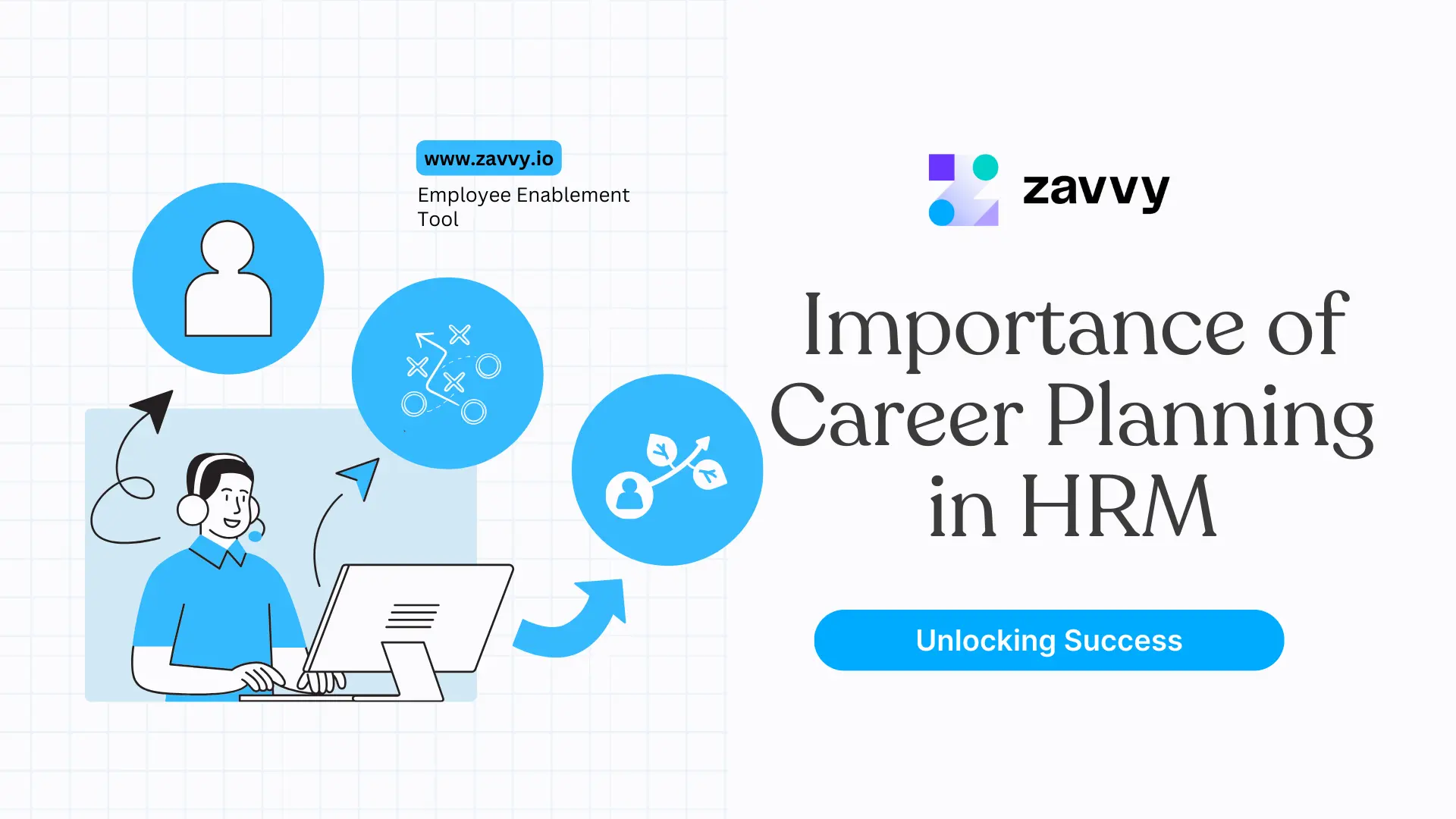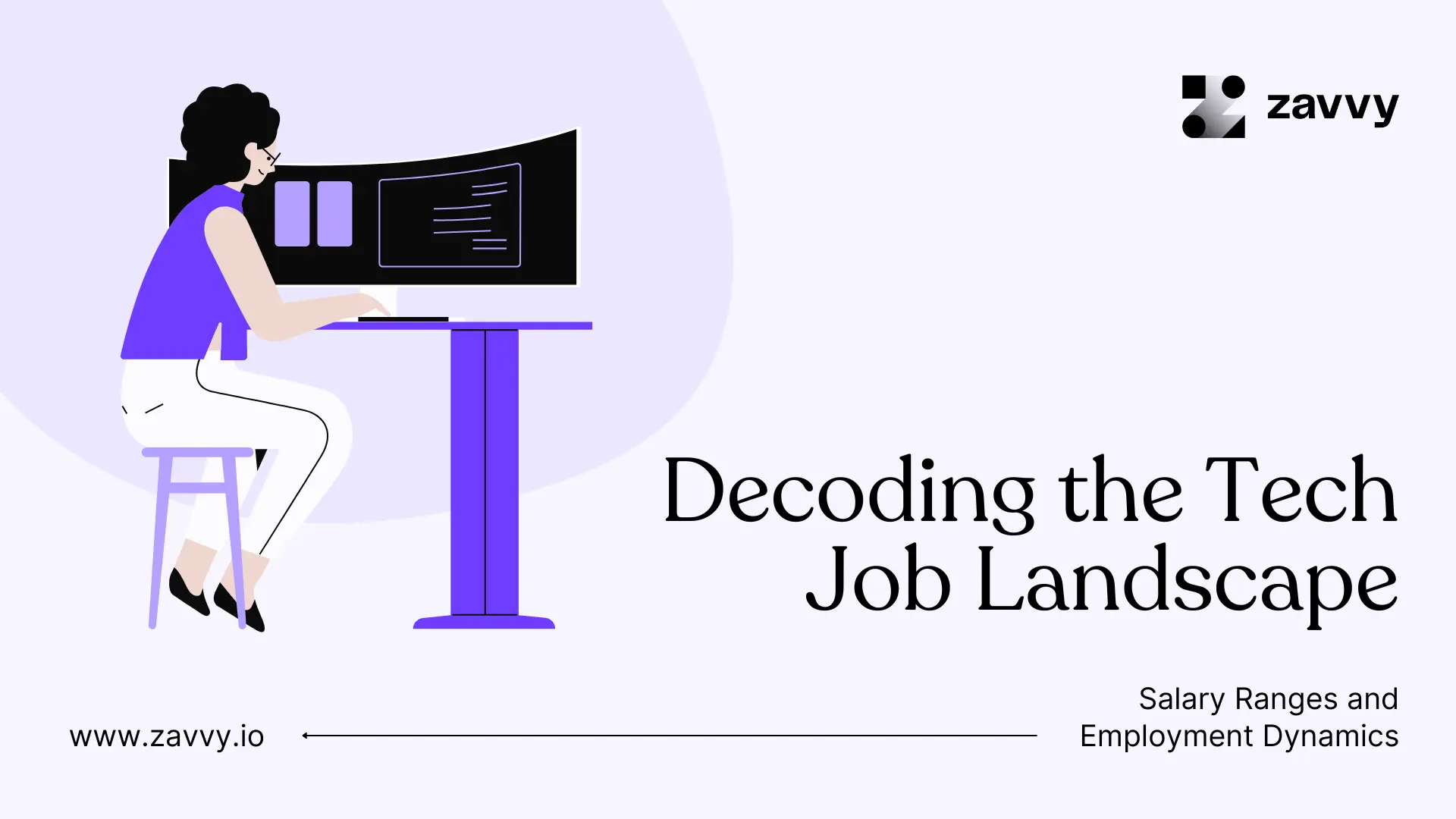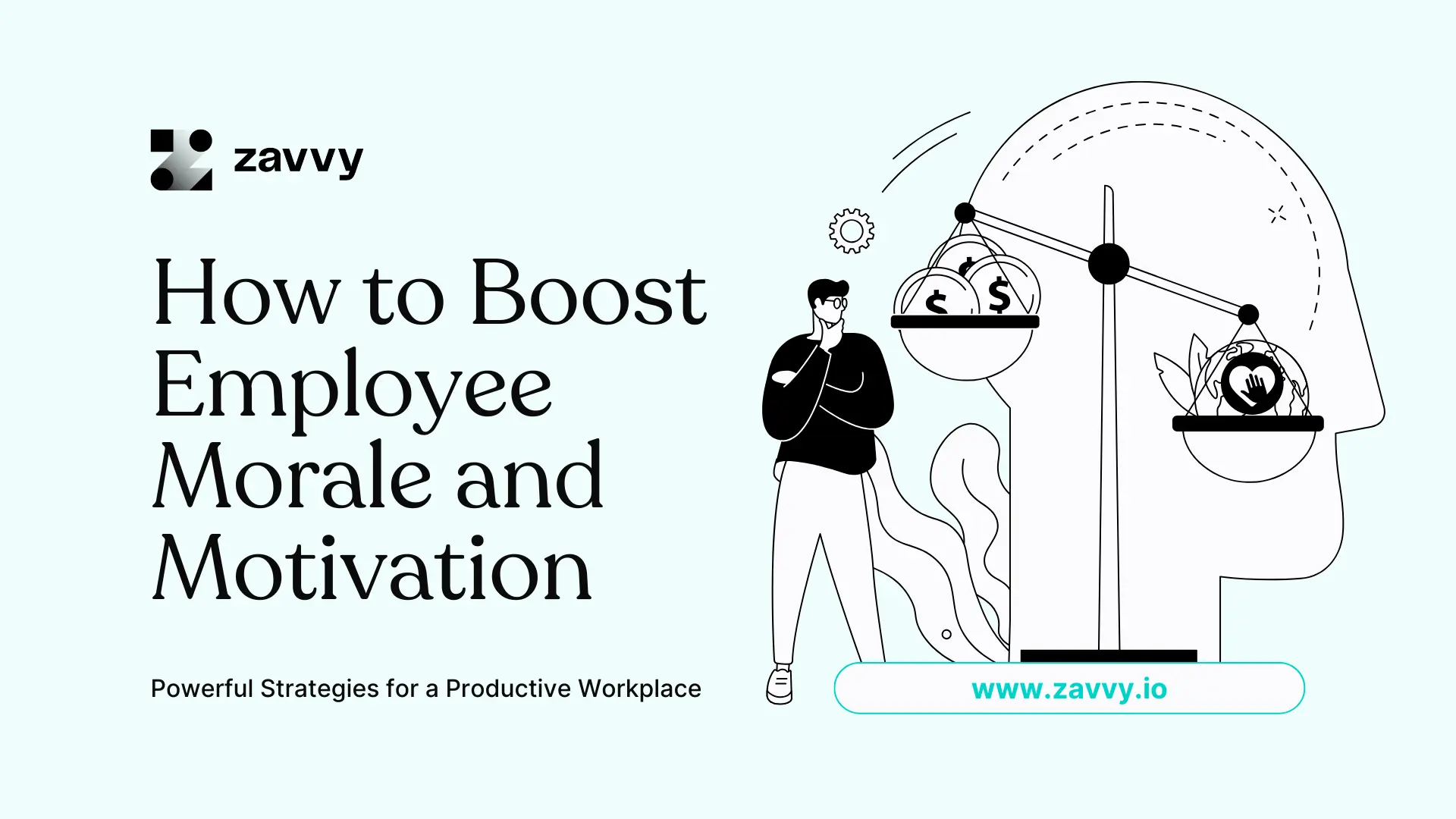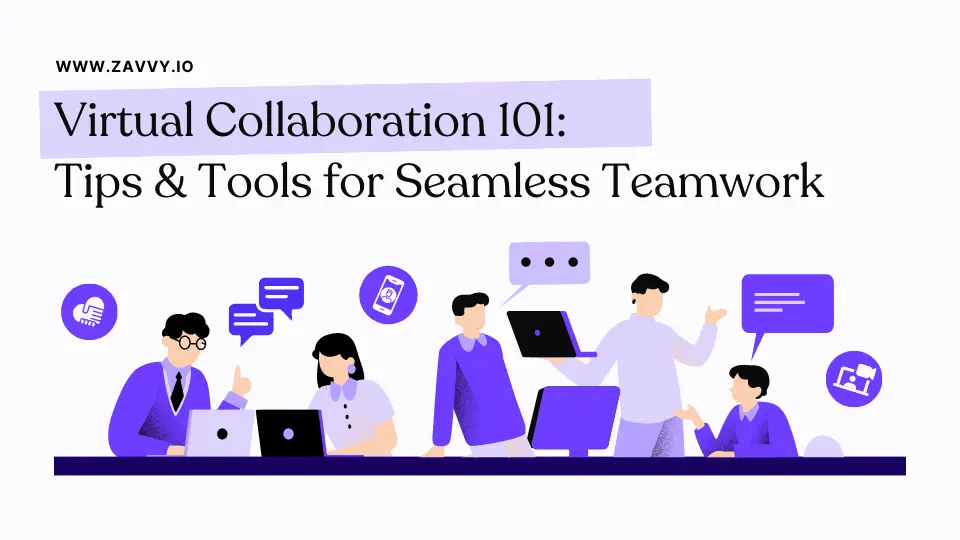
12 Career Progression Examples: Inspiration for Your Pathways
Zuletzt aktualisiert:
9.1.2024
Lesezeit:
8 minutes
última actualización
9.1.2024
tiempo de lectura
8 minutes
Last updated:
January 9, 2024
Time to read:
8 minutes
.webp)
Without a clear map, employees get lost. And when they get lost, they might as well leave.
A clear career progression framework helps your employees understand where they are in their career - and what other opportunities for professional development are waiting for them within the company.
We carefully curated 10+ career progression framework examples to inspire your internal efforts.

🧭 What is a career pathway or career framework?
A career path framework defines competencies needed for specific roles and seniority levels within a company.
The primary purpose of career pathways is to give employees clarity on their possible role progression within a company and help them identify shortcomings.
It's important to understand the mixed skill sets needed for every function within the company to build a strong workforce in the future. This is where career frameworks come in.
Due to their transparent nature, career pathway frameworks have gained immense popularity.

🕵️ Career progression framework examples
Here are some great career frameworks examples and why they should top your list for inspiration.
🖼️ Singular Design
Singular Design is a specialized software development company based in Miami, Florida. They use a very intricate leveling system for their employees' roles. They rely on 5 levels and 15 sublevels as follows:
- (0) Junior (level) A, B, or C (sublevel);
- (1) Advanced A, B, or C;
- (2) Specialist A, B, or C;
- (3) Expert A, B, or C;
- (4) Senior Expert A, B, or C.

Singular Design kicked off their partnership with Zavvy by assessing all employees and assigning them to a level on their intricate leveling matrix.
Once they identified the level of each employee, it was time to create detailed competency-based role descriptions.
To speed up the process, they used Zavvy's AI-powered career Frameworks to create all descriptions for these roles.The best part is that they could generate all descriptions in Spanish, which is their corporate language.
Singular designed connected all the dots - from feedback to competency models, development plans, and guided reminders. All without the frustration of dust-collecting spreadsheets.

➡️ Find out how our development software helps you set up powerful L&D-processes to improve happiness, performance, and employee retention.
📱 Buffer: Horizontal progression
As one of the most famous social media tools designed to manage different accounts on social media networks, Buffer has an elaborate career framework. Buffer believes in remote working as the future and ditched their office set up in 2015 after growing to 50 employees.
The company prides itself in creating a conducive and friendly working environment. This is evident as per their 4.5 out of 5 ratings according to their employees' reviews.
Recently, Buffer came up with a new formal career framework that caters for 'growth opportunities beyond the traditional management track.' This comes after the company realized it is easier to grow horizontally than vertically.

The company has adopted a two-path framework with levels (rows) and steps (columns). Moving from one step to another increases employee position complexity, knowledge, expertise, and the general scope.
A jump in levels transpires through a standardization process and includes the guidance of other departments. This is typically what a traditional promotion entails.
Steps are horizontal and describe smaller advancements.
An employee can move multiple steps at a time under the particular area director's supervision. A change in steps doesn't require approval from other departments.
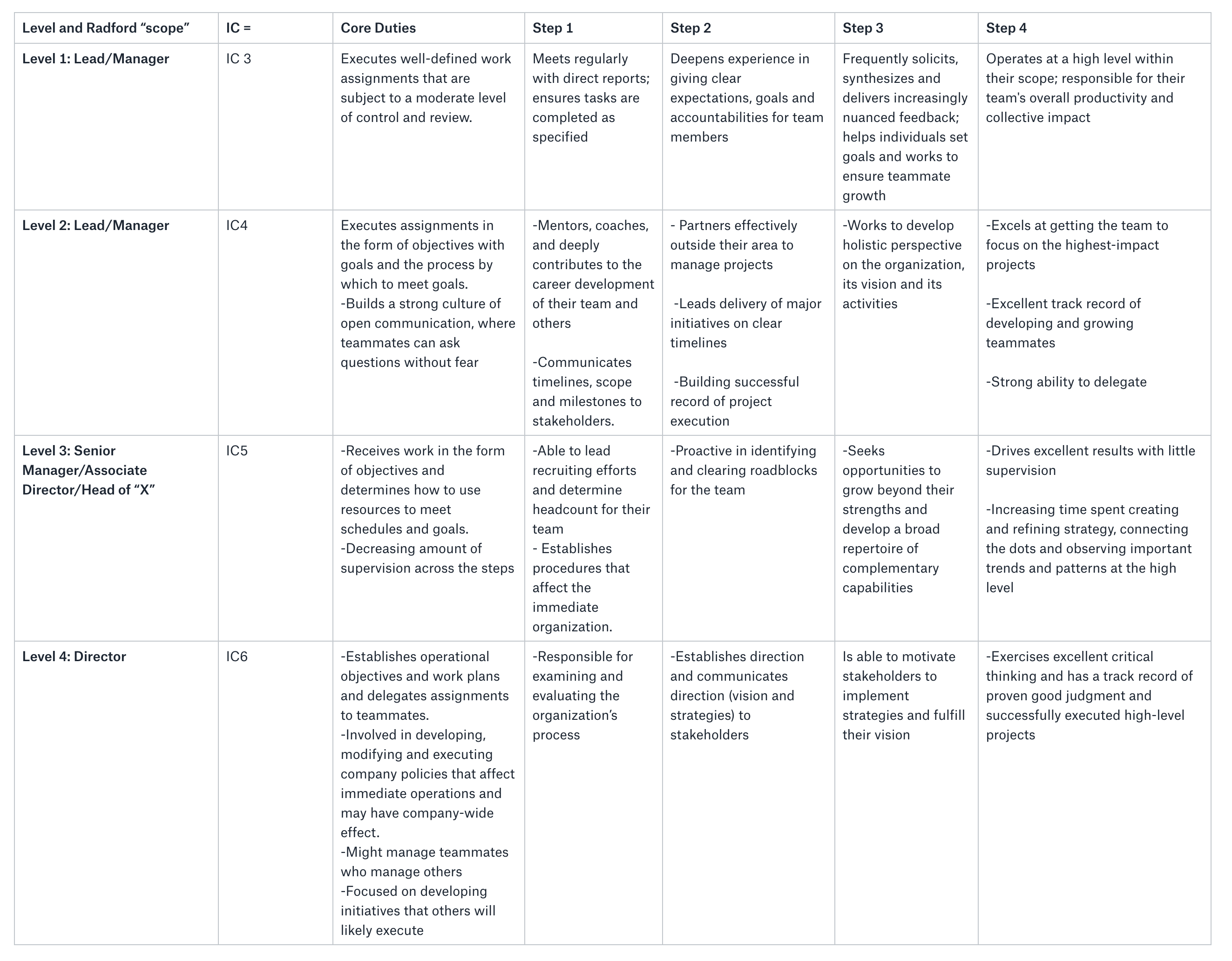
For example, a recently promoted engineering manager at Buffer can be in level 2 step 1.
🎶 Spotify: Technology career track
The Swedish music streaming service is one of the largest tech companies, with over 400 million monthly users.
Spotify strives to ensure that as their employees grow their careers, they bring a more significant impact in the company.
The company's career framework is known as The Steps Framework. It has three main elements;
- A discipline
- A role
- A step
A discipline is an area of expertise an employee has, for example, software development, engineering, project management, etc.
A role refers to how a person interacts with the team, department, or discipline. Examples include software engineer, product insights manager, and associate data scientist.
Lastly, a step is a set of behaviors and expectations connected with an employee's impact on the company. Their step determines an employee's remuneration. Technically, steps are measured by personal growth.
A person's steps are between them and their respective manager. However, since Spotify believes in transparency, individual steps are evaluated in public after a while. It is important to note that behaviors and expectations vary at different steps.
The greater an employee's role and impact, the more the company expects from them.

In general, a teammate's career path majorly involves taking steps to increase their impact on the company as they advance in particular roles in specific disciplines.
🗃️ Dropbox: Engineering career framework
If you're active in the online world, you've probably come across Dropbox several times.
Dropbox is a modern file hosting service platform that securely stores files. It enables users to collaborate, share and sync the files with friends, family, and coworkers from any device.
As a renowned SaaS company, Dropbox' engineering career framework is divided into two components;
- Level expectations define the different levels' roles, functions, and expectations for the impact.
- Core and craft responsibilities - the specific behaviors associated with an employee's position.

The Dropbox framework is majorly based on impact. And impact, in a nutshell, means serving customers better to help Dropbox succeed.
To navigate this framework, employees have to:
- First, create a long-lasting impact.
- Clearly understand the expectations for their team and level. The company provides a summarized description, reach, the scope of the role, and levers impact at each level.
- Analyze the expected conduct regarding culture pillars, talent, direction, and results from the role's primary responsibilities.
- Carefully understand their craft expectation as per the technical proficiency an employee must master at that level.
- Finally, have a meeting with the area manager to set the goals for the season.
This is a detailed step-by-step career framework that helps employees and the organization grow.
🎸 Songkick: Career growth framework
Most concert lovers are familiar with Songkick. This concert discovery platform is owned by the multinational entertainment giant Warner Music Group.
However, there is a reason why the company is labeled as a good place for people to kickstart their careers, and here's why.
To complete the career growth framework, Songkick divided the roles and responsibilities into two pieces:
- "Developer and individual contributor" steps consist of the developers who build and maintain software and the individual contributors who are technically the experts.
- "People management" steps are for the people in leadership positions responsible for growing the teams.
Each step has different roles indicated in the growth framework document.

Seven skills cut across all roles:
- Leadership
- Mentorship
- Technical skills
- Communication
- Emotional intelligence
- Delivery
- Business knowledge.
Whether an employee should move from one role to another is a discussion between the person and respective manager.
However, they must master a good percentage of the responsibilities between 3-6 months to be deemed ready to move to the next step.
The Songkick career framework is unique because it's built with the team's combined efforts.
🏦 Wise: Product management career map
Wise Transfer is taking over the online money transfer industry thanks to its minimal charge for overseas transfers.
Wise revamped their career paths after noticing that the existing framework lacks in-depth role specification details - an essential aspect.
Currently, Wise's Product career path is divided into 6 different career levels.
Each job title comes with a comprehensive description of the skills, responsibilities and behavioral indicators for success.
The different levels give employees a clear view of what is expected at each level and how they can progress to the next.
All employees undergo an annual review even with the career path in place. This helps in refining the development plans.

🏦 Wise: Engineering career map - Individual contributor and lead

Similarly to the Product career path, the engineer career track for individual contributors has 5 career levels.
What is different, is the addition of an Engineering Leads track with 3 levels:
- Engineering Lead
- Senior Engineering Lead
- Director of Engineering.

Note that all levels are clearly documented with:
- Scope: Area of influence for the specific role.
- Impact: That specific role and their team’s impact on Wise, peers and customers.
- Behavior: Soft skills, mentoring, coaching, culture, support, team contribution and advocacy.
- Expertise: Technical, design, architectural, process and organizational skills.
🛒 Lyst
Lyst provides its users with a simplified modern shopping experience which translates to its career framework.
A couple of years back, the company implemented progression in its career ladder to help user researchers and product designers grow.

Luckily for them, they didn't have to start from scratch. Most of their ideas are borrowed from Buzzfeed, which openly sources their internal documentation.
Lyst's career framework is divided into levels. The career ladder describes the different expectations for each role required for an employee to move from one level to another.
Each level is a role summary.

They further break down the roles into specific disciplines and generalized skills. For example, in the skill UX Design roles, for Level 1 (junior position), an employee requires 'an understanding of the multi-step and cross-platform flows.'
The more is required from a given skill, the more it is essential at that particular stage.
🚀 Kickstarter: Engineering and Data career paths
The crowdfunding company's framework is basically a ladder with different steps. Kickstarter engineering and data roles have three different career paths:
- technical,
- data,
- and people.
The distinction in each role is based on skill sets and techniques in literature and research.
Technical roles are those that don't revolve around people's leadership. Most engineering positions fit in this category.

Data refers to roles built around the data team. People are all about leadership and management with the engineering scope.
There are ranks or categories within each role an employee can rise to. The Kickstarter framework is presented in a straightforward document with clearly defined roles for each job family.
💬 Intercom: Product design career framework - IC & management career paths
Intercom is a messaging platform with over 630 employees. Often, companies with such a large number of employees have unclear deliverables. This is where career ladders come to the rescue.
Intercom uses parallel career paths, differentiating individual contributor career paths and management career paths.


We particularly like Intercom's product management career framework. Their approach to the ladder uses buckets. These buckets refer to the skill areas:
- Insight-driven
- Strategy
- Execution
- Driving outcomes
- Leadership skills and behaviors.
In each bucket, there are two to four different areas.

For product designers, the career pathway uses job levels in laying out employees' expected roles. They have five levels; associate, mid-level, senior, staff, and principal.
The company introduced a new staff designer level to eliminate the senior and principal levels gap. This has helped improve the quality of designs and the rate at which tasks are executed.
They trimmed down the competencies required for product designers into three categories:
- Strategy
- Execution
- Behaviors.
This strategy has added more meaning to the job description. Moving up job levels is no longer just a checklist but beneficial to the entire company.
👨 Gusto
Gusto is a cloud-based platform that helps businesses insure, pay, and support, their employees.
When we look at the company's product managers, they are evaluated using four attributes:
- contribution to product milestones;
- contribution to company strategy;
- contribution to product team success;
- contribution to other teams' success;
Six different levels further break down each attribute.

A person is only promoted if they can consistently perform all attributes across that level.
For example, if an attribute at level 5 is to "Mentor team members in the company," the product development manager should mentor all team members from level 1 to 5.
Sometimes, a PM at Gusto is in between levels. This happens when they can fully meet their expectations at their current status and show capabilities of performing in the next one. Therefore, moving forward is withheld until they can clearly perform all the next level attributes.
When new employees join the Gusto team, they are added to the highest level to perform well. This way, they can outshine the expectations set and not disappoint fellow teammates.
Gusto's career pathway framework is used in performance reviews, onboarding, employee evaluation, and promotions.
🏠 Carta
Previously known as eShares, Carta is an equity management and ownership platform. Carta's engineering career framework has eight levels and an additional level for interns. These levels are similar to other tech companies with just a little tweak.
What determines the movement from one level to another is impact. For example, level 2 is measured by impact on tasks, level 6 is on a team, and the highest is on the industry.
Carta's example of career progression framework isn't linear.
Moving up some levels is relatively more challenging than others.
For example, moving up the "industry's" path is more challenging than progressing on "tasks."
These levels are conservative. In other words, once an employee moves up the ladder, the only way their growth can be revoked is if they leave the company. Therefore, the career progression is relatively slower because of the thorough scrutiny required in the process.
When it comes to compensation, salary increases linearly. In the lower levels, a person's remuneration is their overall compensation - while in the top levels, most of an employee's compensation comes from equity.

According to Carta's career framework, people at higher positions are expected to own their careers. This translates to less guidance and supervision from overhead managers, but more advice and guidance to help them progress your career outside the work scope.
💡 For more examples, check out our Career progression framework collection on Notion.
😃 We also included some examples of competency matrices for individual contributors and leaders.

❌ Beware 7 pitfalls of bad career progression frameworks
When done well, a career framework is a valuable asset in improving employee skill sets, understanding their desires, and driving long-term performance.
We like to think of career pathways as the ideal answer for the commonly asked question, 'where do you see yourself in the next years?'
However, most of the time, organizations don't achieve the expected results from career progression frameworks due to the following mistakes.

Unclear wording
A good framework uses plain and simple English. However, sometimes the terms and phrases used by HR departments are not entirely clear with everyone else in the organization.
For example, words like integrity, discipline, specialization, and authenticity are commonly used.
But, in what context should everyone in the company be applied in their career pathways?
Since career progression frameworks should be used beyond the HR department, switching to more straightforward terms is best. For instance, the word integrity can be changed to honesty and truthfulness if they fit the context.
Poorly articulated competencies
Yes, this title might fall under the unclear wording category mentioned above, but let's break it down to simpler terms.
Competencies are simply the skills and qualities a company is looking for in a particular role.
If your competencies are broad, they won't give sufficient information on what is expected for a specific position.
For example, problem-solving can be one of the essential skills required in a software engineering role.
But, a person with reasonable dispute problem-solving skills isn't necessarily fit for an engineering position.
To avoid this confusion, focus on the specific skills required for a particular description.
Too many competencies
Having too many competencies can be confusing to both employees and assessors. For instance, having a position with 20+ skills required causes you to lose focus on the most critical competencies.
Just imagine trying to assess one person against 20 different skills. This sounds pretty exhausting! You can limit yourself to a maximum of 10 to make it easier for people to redirect their focus on the key contributors for a particular role.
If the competencies in your current framework aren't yielding the desired results, it might be due to poor clarity.

Failure to test your framework
We all know that theory is far from practicality. Many companies don't take an extra step to test their framework on their business to see if it actually works.
A good framework should cut across all sections from recruitment, career progression, role development to succession. Also, validating a framework helps test its longevity and reliability in an actual working environment.
It can also serve as an excellent way to compare its impact on your organization against other competitor companies.
Lack of proper tools and resources
Failure to have the proper tools, resources, and software in place means you won't streamline the employee management process. However, with the right resources, such as competency framework software, you'll be able to create an elaborate framework with minimal administrative resources.
The same applies to implementing career pathways. For example, to ensure proper employee management, the current employees in managerial positions should undergo leadership training.
Having the right tools and resources ensures nothing is missed!
Insufficient (internal) research
Research doesn't necessarily entail the HR department spending tons of hours reading and clicking through internet pages or flipping pages of manuals. In this case, we are talking about research within the existing workforce.
Without consultation with different job families in the company, the framework may not apply in the organization. Alternatively, it may be applicable, but since employees were not involved, they may be hesitant to accommodate it.
Your team should feel a framework is something done for them, not to them.
Non-inclusive behaviors
Several career frameworks tend to cover positive behaviors only. However, as some skills are assets, they can be a liability when not correctly employed.
For example, being decisive is one of the primary competencies, especially in managerial positions. However, being overly assertive can block collaboration which is also essential in teamwork.
Therefore, when setting a career framework, you can clearly set boundaries for each strong suit or instead skill required.
➡️ Set-up a company-wide career pathing framework in just a few clicks with Zavvy
Anyone that ever attempted creating a career framework from scratch knows what a massive task it is.
And the worst part is that you're never fully done. As industries and technologies continuously evolve, so are competency needs. So your today's skills may be obsolete in the future.
But picture this: A fully customized career progression framework, created in minutes.
Sounds too good to be true? It's not thanks to Zavvy's AI.
You'll have accurate, tailored competency models and role descriptions at your fingertips.
No more tedious manual work. No more second-guessing.
Just results: transparency, clarity and flexibility.

Define the skills, knowledge, and expertise required for each job level. And follow up with the tools to help them take their careers to the next levels.
Is AI is not really the best approach for you? No judgement, we also have solutions for you.
Zavvy comes with an extended gallery of career progression framework templates from various company sizes. You can use these as inspiration.
Plus, our learning experts will support you every step of your creation process.
Get in touch with our specialists to learn how you can get started.

Read next
Als Nächstes lesen
No items found.
No items found.
.png)
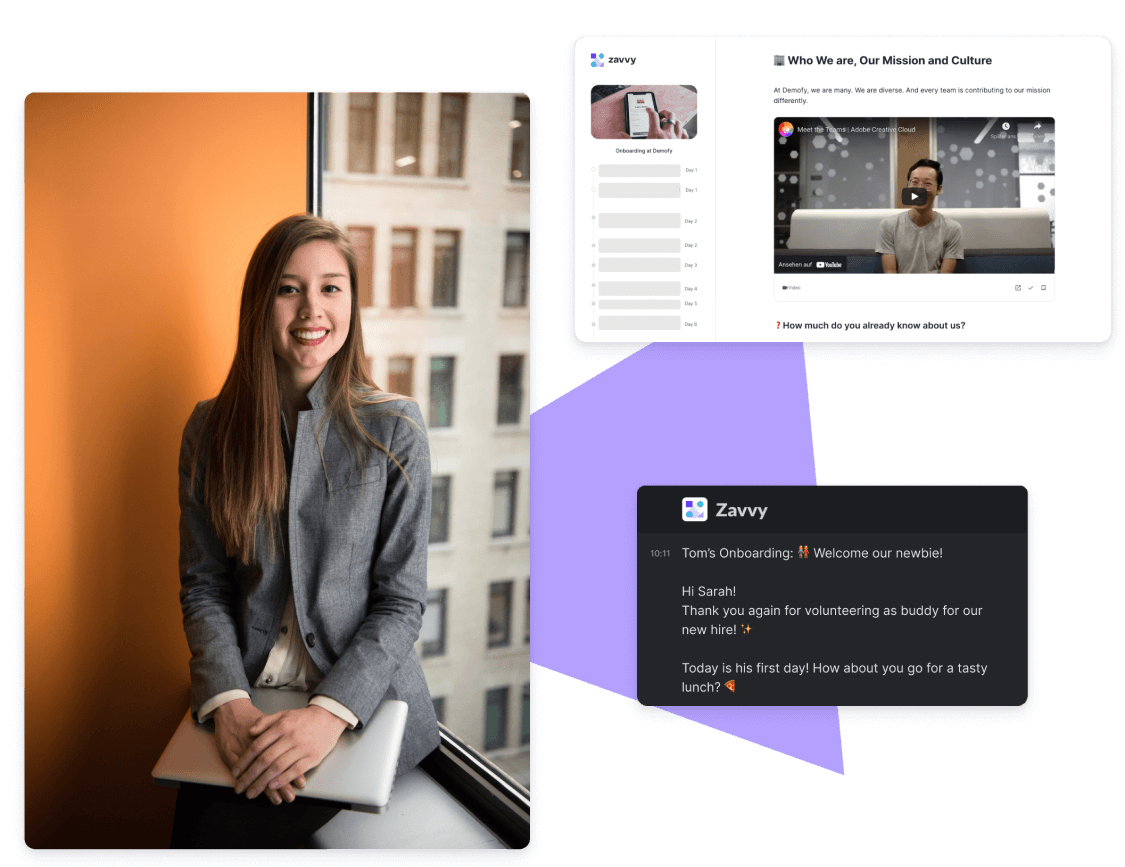



















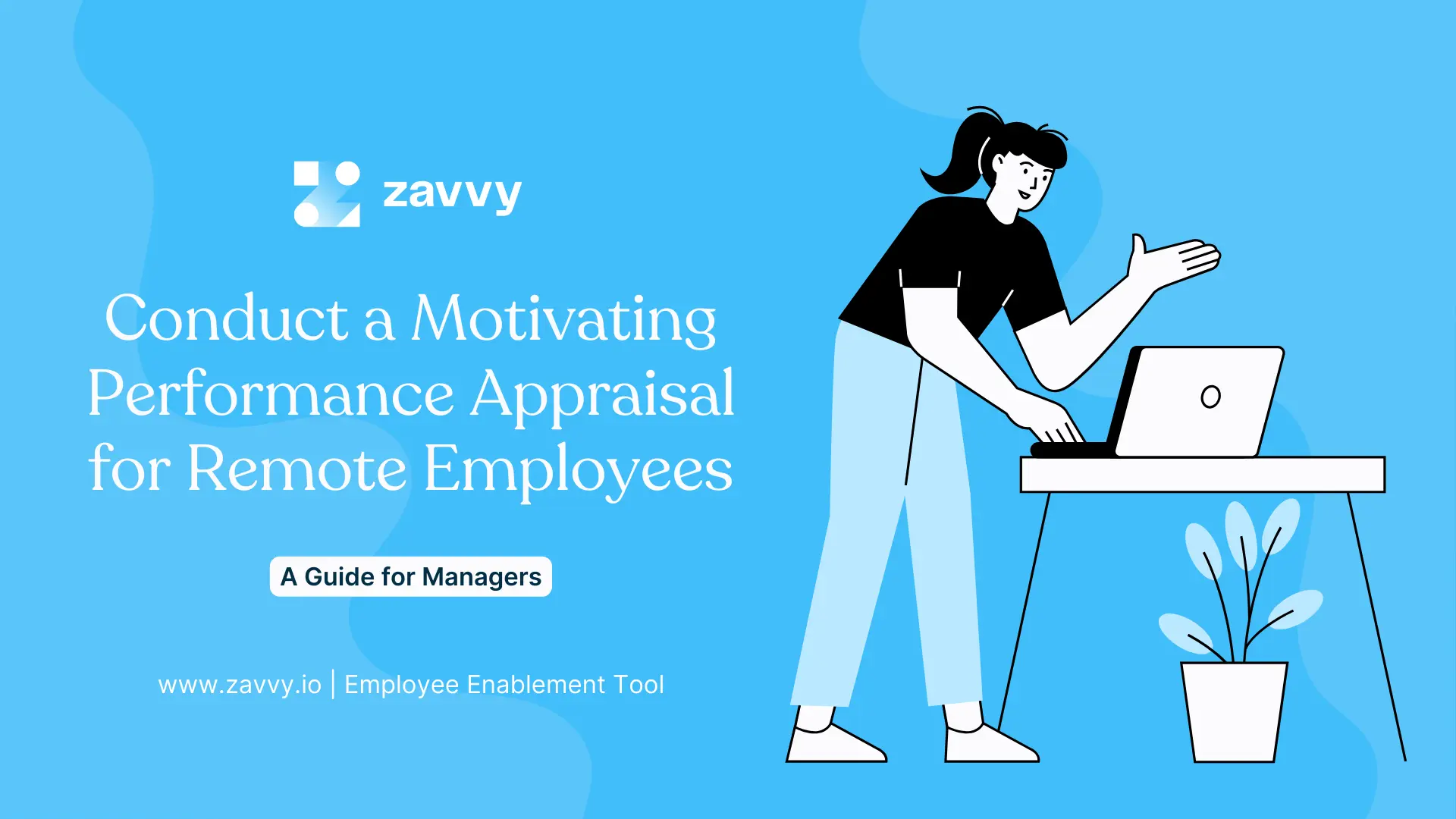
.png)







